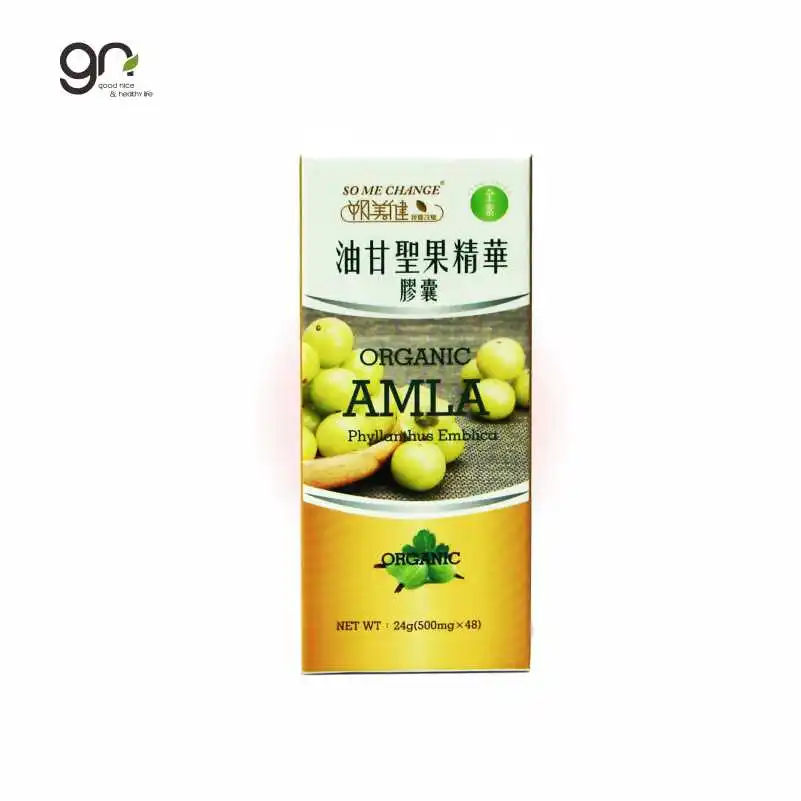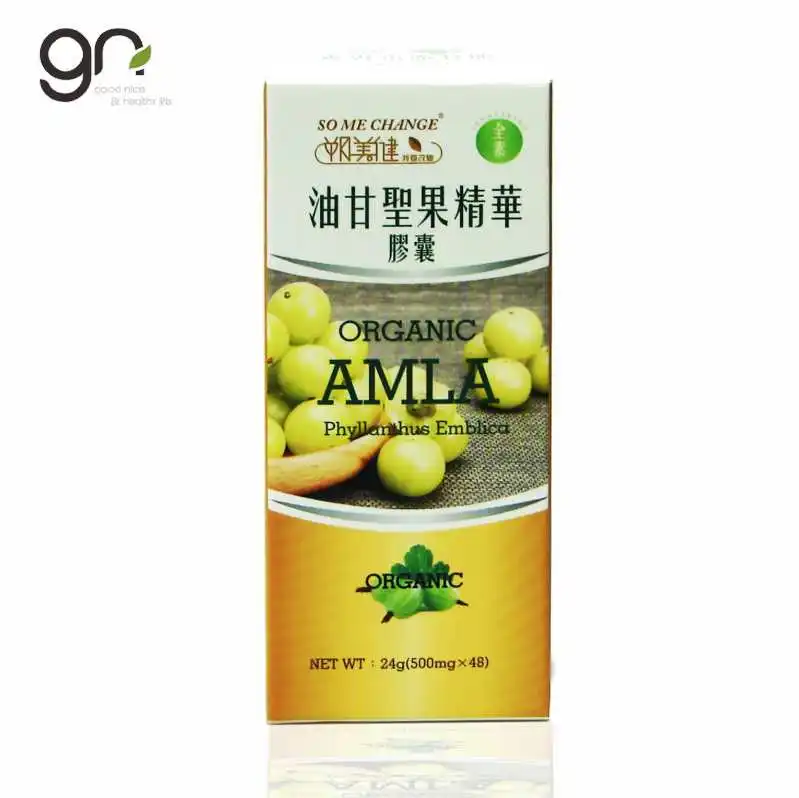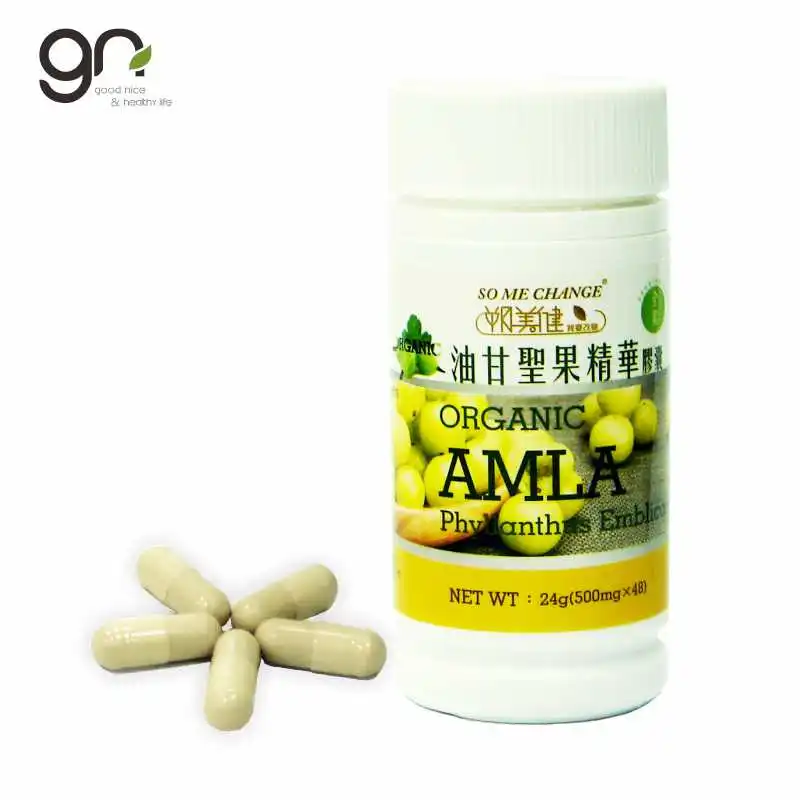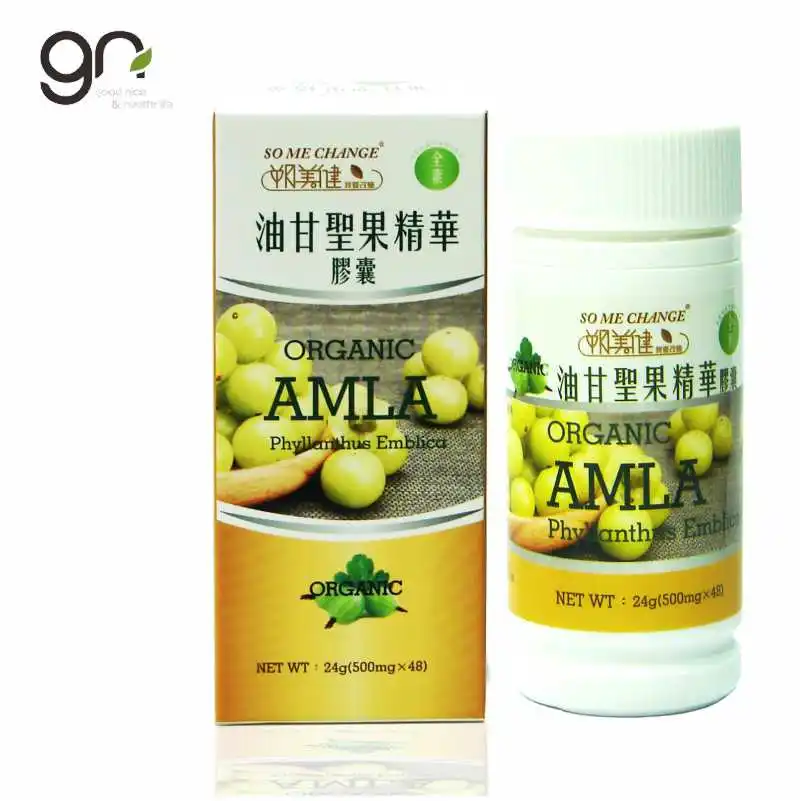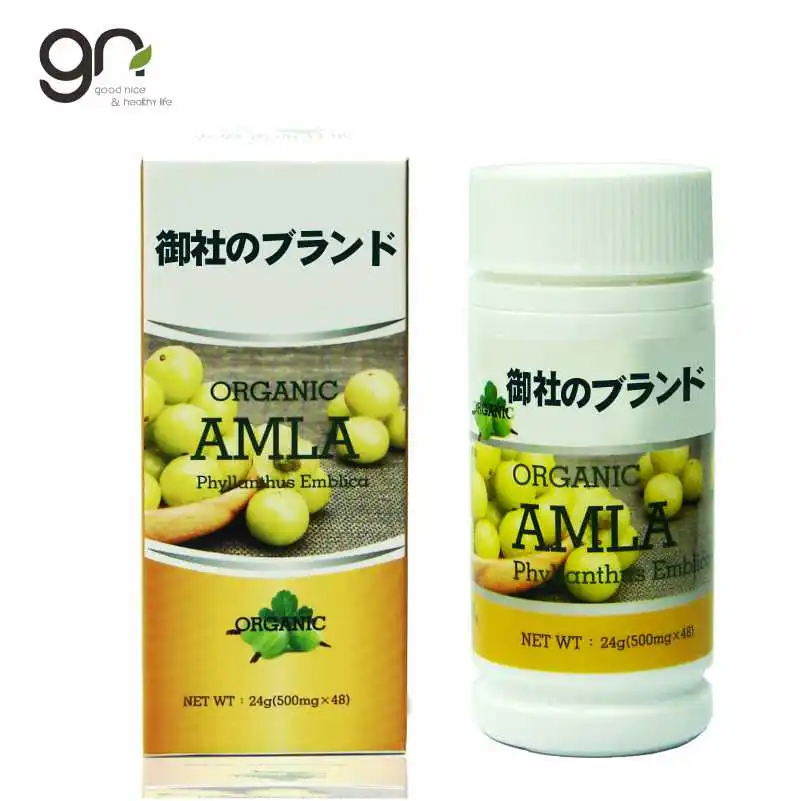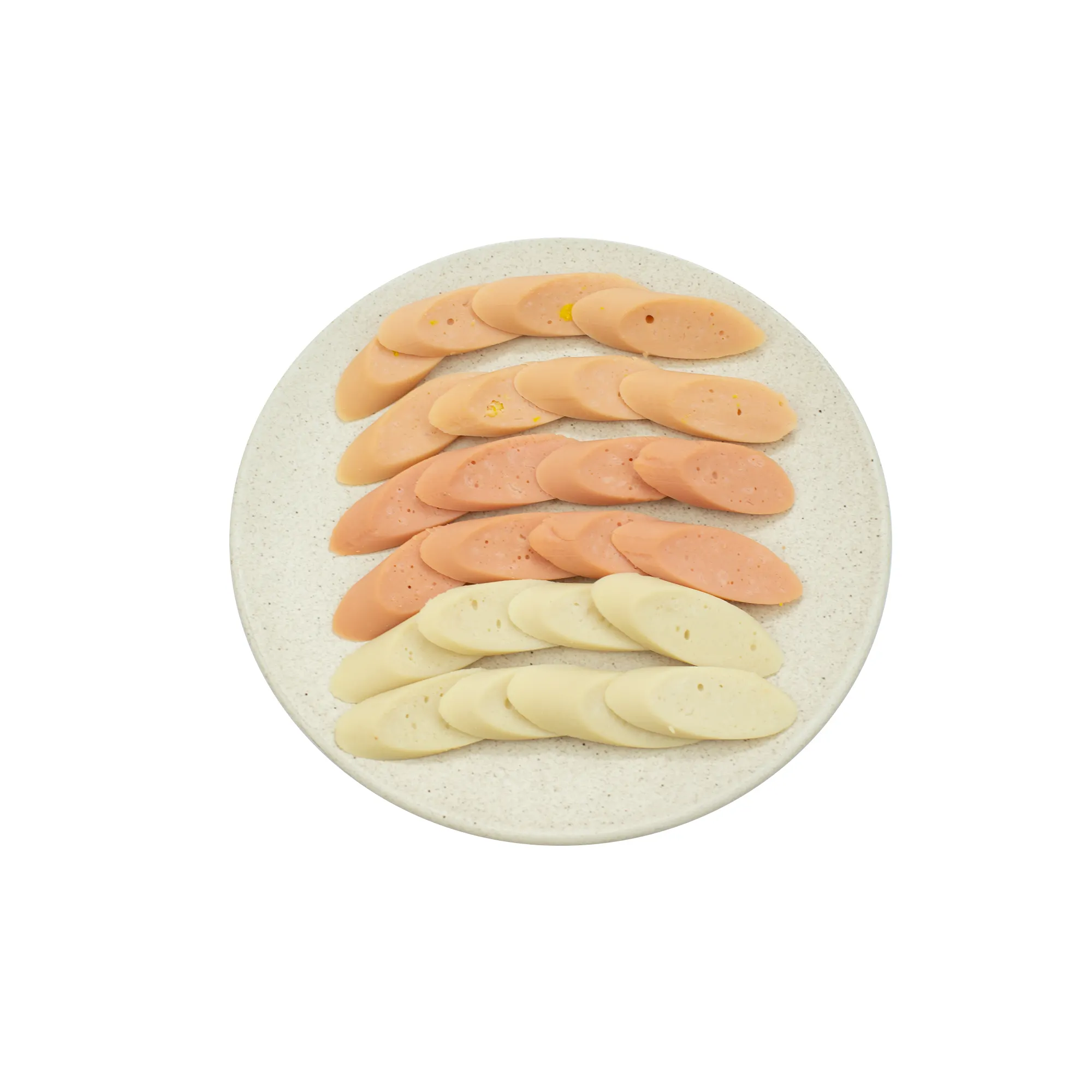Органический порошок Amla Phyllanthus эмблика капсулы high SOD травяные элементы делают вашу кожу
- Категория: Прочие продукты и напитки >>>
- Поставщик: GOOD,NICE,DEVELOPMENT,TECHNOLOGY,CO.,LTD.
Поделиться:
Описание и отзывы
Трекер стоимости
| Месяц | Минимальная цена | Макс. стоимость |
|---|---|---|
| Aug-17-2025 | 6.41 $* | 6.23 $* |
| Jul-17-2025 | 5.23 $* | 5.83 $* |
| Jun-17-2025 | 6.48 $* | 6.63 $* |
| May-17-2025 | 6.50 $* | 6.38 $* |
| Apr-17-2025 | 5.10 $* | 5.4 $* |
| Mar-17-2025 | 6.6 $* | 6.85 $* |
| Feb-17-2025 | 6.4 $* | 6.19 $* |
| Jan-17-2025 | 6.78 $* | 6.86 $* |
Характеристики
Product Description
Phyllanthus Emblica has 164 times the vitamins, 2182 times the selenium and 4107 times the SOD of apples. The strength of antioxidant capacity is as high as 440-270, and its value is 1770 expressed as oxygen radical absorption capacity (H-ORC).

The US Federal Food Administration regards Phyllanthus emblica as an "anti-aging factor, a holy beauty product" as a health plant worthy of promotion and cultivation by the United Nations Health Organization.
Product Name | Organic AMLA Phyllanthus Emblica |
Main Ingredient | Phyllanthus Emblica fruit powder |
Function | Nutritional supplement Health powder Products |
Volume | 48 pcs / case / 72 case / box |

The origin of Phyllanthus emblica: It has been passed down thousands of years ago. The Indian monks living in the Himalayas villages were in a bad climate. They discovered that the nearby monkeys would gather a yellow-green fruit to use. Not long after these monkeys were lively and more Energetic, energetic, and much healthier than monkeys in other places. Later, they also began to learn monkeys to collect the same fruits and use them. The magic is that when they use the fruits for a long time, their mental and physical strength will become better and better, so the monks put this The fruit tells nearby villagers that it is also widely planted and promoted. This is the origin of the sacred fruit in India. In the Indian health regimen. Emblicia is the most frequently used herb and is honored as the sacred fruit of India.
Introduction of Phyllanthus emblica: It is recorded in Buddhist scriptures that there is a kind of fruit in Tianzhu called Anmoluo (or Anmolojia), which is actually Amla (AMLA), which belongs to Euphorbiaceae Phyllanthus. The unique flavor of Ganzi is sour, astringent, bitter and spicy; after eating, Phyllanthus emblica is later known as Phyllanthus emblica. It is common in Hong Kong, Taiwan, China's Lingnan region, India and Southeast Asian countries. From April to June every spring and summer, the Phyllanthus emblica tree will bloom a bunch of small yellow flowers. In summer, it can be eaten fresh from July to September. The surface is brown to dark green, with light yellow granular protrusions, wrinkles and Unobvious 6-sided, fruit pedicel about 1mm. The mesocarp is 1 to 4 mm thick, hard and brittle. The endocarp is yellow-white. It is a round fruit, light green or light yellow. The fresh fruit can be eaten raw, can also be processed into powder or processed into high-grade preserves. Taste is sour, slightly astringent and bitter, sweet and fragrant. It is bitter and sweet after eating, and there is still sweetness in the mouth. It can produce fluid and quench thirst. The nutritional value of this fruit is very high. .
Phyllanthus emblica, as a kind of medicinal and edible fruit, has been included in the list of "both food and medicine" by the Ministry of Health, and it has also been designated by the United Nations Health Organization as one of the three health-care plants to be planted around the world. Organize experts to conduct experimental research, development and utilization.
It has broad application prospects in many fields such as medicine and cosmetics. It is also one of the traditional Tibetan medicinal materials. It is often referred to as the three major fruits in Tibetan medicine along with Myrobalan and Myrobalan, and is used very frequently.
Phyllanthus emblica characteristics: Phyllanthus emblica has a unique flavor, astringent, bitter and spicy. After eating Phyllanthus emblica, the fruit can be eaten fresh or used for medicinal purposes. It is regarded as a sacred fruit in India. Especially more valuable is that the vitamin C contained in the Phyllanthus emblica fruits is very stable at high temperatures. According to the test, after baking at 100°C for 4 hours and 80°C for 8 hours, the vitamin C still preserves 79% to 93%. This is rare in other fruits.
Phyllanthus emblica
[Superoxide dismutase] (SOD) has high temperature stability, the activity retention rate of fruit powder is still more than 97% when heated at 100℃, and its storage durability is good. After one year of sealed room temperature storage, the SOD content is still more than 98%
Nutrients of Phyllanthus emblica: In addition to the high amount of vitamin C, there are calcium, phosphorus, iron, potassium, zinc, superoxide dismutase (SOD), rich organic selenium, and 17 kinds of amino acids and trace elements, including what the human body needs The 8 kinds of amino acids, which also contain tannins, organic acids, phenolic acids, bioflavonoids, three types of compounds and many different natural plant nutrients. Among them, vitamin C is famous for its high content, which is 20 times that of citrus and 100 times that of apples and 3-5 times that of kiwi fruit. "Vitamin C" is a water-soluble vitamin that most animals can synthesize in the body. Guinea pigs lack certain enzymes, so they can’t synthesize vitamin C, so they must be ingested from food, which has extremely high nutritional value.
Benefits of Phyllanthus emblica: Phyllanthus emblica is rich in vitamins CEB and other trace elements; minerals, superoxide dismutase SOD, 17 kinds of amino acids, including 8 kinds of amino acids and organic selenium required by the human body, regulate physiological functions, nutritional supplements, and maintenance Healthy and energetic.
"Superoxide dismutase" (SOD) is a source of youthful vitality. It also provides a variety of beauty effects for your hair and skin
Phyllanthus emblica powder with high fiber can promote intestinal peristalsis and help smooth bowel movements.
Introduction of Phyllanthus emblica: It is recorded in Buddhist scriptures that there is a kind of fruit in Tianzhu called Anmoluo (or Anmolojia), which is actually Amla (AMLA), which belongs to Euphorbiaceae Phyllanthus. The unique flavor of Ganzi is sour, astringent, bitter and spicy; after eating, Phyllanthus emblica is later known as Phyllanthus emblica. It is common in Hong Kong, Taiwan, China's Lingnan region, India and Southeast Asian countries. From April to June every spring and summer, the Phyllanthus emblica tree will bloom a bunch of small yellow flowers. In summer, it can be eaten fresh from July to September. The surface is brown to dark green, with light yellow granular protrusions, wrinkles and Unobvious 6-sided, fruit pedicel about 1mm. The mesocarp is 1 to 4 mm thick, hard and brittle. The endocarp is yellow-white. It is a round fruit, light green or light yellow. The fresh fruit can be eaten raw, can also be processed into powder or processed into high-grade preserves. Taste is sour, slightly astringent and bitter, sweet and fragrant. It is bitter and sweet after eating, and there is still sweetness in the mouth. It can produce fluid and quench thirst. The nutritional value of this fruit is very high. .
Phyllanthus emblica, as a kind of medicinal and edible fruit, has been included in the list of "both food and medicine" by the Ministry of Health, and it has also been designated by the United Nations Health Organization as one of the three health-care plants to be planted around the world. Organize experts to conduct experimental research, development and utilization.
It has broad application prospects in many fields such as medicine and cosmetics. It is also one of the traditional Tibetan medicinal materials. It is often referred to as the three major fruits in Tibetan medicine along with Myrobalan and Myrobalan, and is used very frequently.
Phyllanthus emblica characteristics: Phyllanthus emblica has a unique flavor, astringent, bitter and spicy. After eating Phyllanthus emblica, the fruit can be eaten fresh or used for medicinal purposes. It is regarded as a sacred fruit in India. Especially more valuable is that the vitamin C contained in the Phyllanthus emblica fruits is very stable at high temperatures. According to the test, after baking at 100°C for 4 hours and 80°C for 8 hours, the vitamin C still preserves 79% to 93%. This is rare in other fruits.
Phyllanthus emblica
[Superoxide dismutase] (SOD) has high temperature stability, the activity retention rate of fruit powder is still more than 97% when heated at 100℃, and its storage durability is good. After one year of sealed room temperature storage, the SOD content is still more than 98%
Nutrients of Phyllanthus emblica: In addition to the high amount of vitamin C, there are calcium, phosphorus, iron, potassium, zinc, superoxide dismutase (SOD), rich organic selenium, and 17 kinds of amino acids and trace elements, including what the human body needs The 8 kinds of amino acids, which also contain tannins, organic acids, phenolic acids, bioflavonoids, three types of compounds and many different natural plant nutrients. Among them, vitamin C is famous for its high content, which is 20 times that of citrus and 100 times that of apples and 3-5 times that of kiwi fruit. "Vitamin C" is a water-soluble vitamin that most animals can synthesize in the body. Guinea pigs lack certain enzymes, so they can’t synthesize vitamin C, so they must be ingested from food, which has extremely high nutritional value.
Benefits of Phyllanthus emblica: Phyllanthus emblica is rich in vitamins CEB and other trace elements; minerals, superoxide dismutase SOD, 17 kinds of amino acids, including 8 kinds of amino acids and organic selenium required by the human body, regulate physiological functions, nutritional supplements, and maintenance Healthy and energetic.
"Superoxide dismutase" (SOD) is a source of youthful vitality. It also provides a variety of beauty effects for your hair and skin
Phyllanthus emblica powder with high fiber can promote intestinal peristalsis and help smooth bowel movements.
The shipping fee reference table for this product by Chunghwa Post
Packaging details of this product : 72 bottles inside / Size 31x31x24cm / Gross weight 6.2Kg
Country or area | Shipping Charge | Estimated delivery time |
U.S.A /Canada | USD80 | 4-5 days |
United Kingdom / France / Germany / Italy /Netherland /Russia | USD80 | 4-5 days |
Spain | USD80 | 5-7 days |
Japan / South Korea /Turkey /Thailand / Malaysia Philippines / Indonesia /Singapore / Vietnam/ Israel / India | USD50 | 3-4 days |
Saudi Arabia / United Arab Emirates | USD50 | 5-7 days |
Azerbaijan /Ukraine | USD80 | 5-7 days |
Estonia | USD80 | 5-11 days |
Australia | USD75 | 4-6 days |
Mexico / Brazil /Colombia | USD110 | 5-6 days |
South Africa | USD110 | 4-5 days |
Related Products



$5.5 - $ 9.5 case
50 cases (MOQ)
$5.5 - $ 9.5 Case
85 cases (MOQ)
$5.5 - $ 9.5 case
72 cases (MOQ)
Certificate



Certificate introduction
Certificate introduction
Certificate introduction
Company Introduction






FAQ
Welcome to specify the trademark label that suits you. We can use printing or stickers to complete what you specify.

Order notice
If the designated product is packed in jar , the quantity of each box must be a multiple of the box specifications to prevent damage during transportation.
Warning
1. If you do not have a designated delivery company or a pickup company, our company will carry out the delivery according to the appropriate freight company in each country.
1. If you do not have a designated delivery company or a pickup company, our company will carry out the delivery according to the appropriate freight company in each country.
2. Before printing the outer box, please prompt the relevant prohibitions of the importing country, otherwise, please provide the design manuscript by yourself. If the customs cannot be cleared due to this, the company cannot be responsible.
General Q&A
Q1: Could I print my own brand / logo on the goods?
General Q&A
Q1: Could I print my own brand / logo on the goods?
R: Sure, OEM/printing logo is welcomed based on MOQ. Please show Brand Licensing and provide the original logo file.
Q2: What's the MOQ if I want to print my own brand/logo?
R: The MOQ will be decided by your customized products. As usual, it needs 1000 sets.
Q3: Can I make a sample based on my demand?
R: Certainly, we have professional engineer to make a proof before order OEM mass product.
